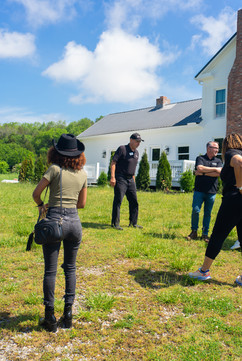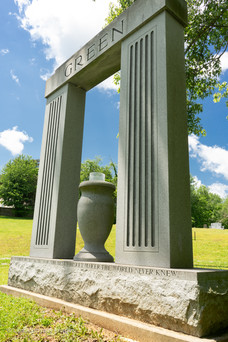Our Nearest Legacy Tour
- Lipstickroyalty Agency Staff

- May 23, 2023
- 4 min read
A unique and beautifully filmed short by Lipstickroyalty Images Production
Founders of Lipstickroyalty Agency Shawn and Regina Smiley were invited to Tennessee to attend an invite-only Legacy Tour. Day one kicked off in Nashville Tennessee where a private dinner was curated and prepared.
Other partners, reps, and friends of the brand were invited to the trip and attended the dinner.
As featured in the short, day two included a tour of the Dan Call Farm, Highview Cemetery, and the new Nearest Green Distillery. The interactive tour was a one-of-a-kind experience that took guests on a journey from where Nearest Green first made Tennessee whiskey, to where the Green and Daniels family was laid to rest, followed by an exclusive tour of the Nearest Green Distillery. Lunch included a savory BBQ menu from their inhouse BBQ restaurant and guests were treated to a whiskey tasting which featured variations of the Nearest Whiskey, and an in-depth look into how and where the whiskey is made, some of the Weaver’s favorite places on the farm, a private experience in the Speakeasy and so much more!
“My life has forever changed after experiencing this tour. It was empowering to witness in person how much history Fawn Weaver and her team have uncovered and preserved. I think everyone should at some point in their life experience the Nearest Green Distillery in person, it’s like something out of a museum,” said Shawn.
Supporters are encouraged to visit www.unclenearest.com to support and learn more about the brand.
The Story of Nearest Green (via. www. Nearestgreen.com)
The story of Nathan “Nearest” Green is one of the most remarkable yet forgotten stories of our lifetime. Uncle Nearest, as his family and friends in his hometown of Lynchburg, Tennessee called him, was the first known African-American master distiller. Born in Maryland around 1820, we don’t know if he was born into slavery or later became a slave, but what we do know is sometime around the mid-1800s, he began working on the farm of a country preacher and distiller in Lincoln County. Nearest was a skilled distiller, specializing in a process that gave his whiskey a unique smoothness, known as sugar maple charcoal filtering. Called the Lincoln County process, it is believed by many whiskey and food historians to have been brought in by slaves, who were already using charcoal to filter their water and purify their foods in West Africa.
Nearest was such a skilled distiller, and his sugar maple charcoal-filtered whiskey was the best in the area. In the mid-185os, a young white boy came to work at the farm where Nearest operated as the master distiller. The young boy was the tenth child in his family and lost his mom to a sudden illness at the age of four months so it wasn’t surprising he began looking for things to do away from his family home. He worked as a chore boy for the preacher─milking cows, feeding slop to the pigs, getting water from the springhouse, and all the other things farm hands do. He wasn’t a privileged boy, he was a worker, like Nearest.
While the young boy worked for the preacher, he kept asking about the smoke coming up through the hollow on the 338-acre property. He knew there were men hurrying back and forth from that area with mules and wagons but he was never allowed to go. Finally, after some time of working as a chore boy, the preacher agreed to give in to the boy’s curiosity and to take him to the area on the property where the smoke came from. Introducing the young boy to a “coal black negro,” as later described in the boy’s biography, by saying, “This is Uncle Nearest. He’s the best whiskey maker I know of,” and asked Nearest to teach the young boy everything he knew about distilling, and especially his process of sugar maple charcoal filtering.
Now, the important thing to know about this special process Nearest taught is the only difference between bourbon and Tennessee whiskey is this special filtration. So, what Nearest was teaching the young boy to do was make Tennessee Whiskey.
As the years went by, the young boy continued learning from Nearest and eventually became old enough to begin selling this unique whiskey in other towns near Lynchburg. He sold to soldiers during the civil war and found he was a great sales person and entrepreneur. The whiskey he sold quickly became the most popular in the area. During the civil war, at the age of 15, the young boy lost his father and became an orphan. He would need to fend for himself all the remaining days of his life and chose the whiskey business as his career. Following the civil war, once Nearest was a free man, the white chore boy-turned business man partnered with the preacher in the distillery and eventually purchased the preacher’s shares and renamed the distillery after himself. The young man asked Nearest to be his first master distiller, an extraordinary request for such a time and place.
Over time, that young white chore boy moved from the property and took his growing whiskey business with him. Although Nearest retired and did not go to his new distillery, Nearest’s sons, Lewis, Eli and George all continued the tradition of making the best whiskey in the area and went to work with the young man at his new place. Nearest’s grandsons, Charlie and Ott also went to work for the new distillery. That young white boy, who became a brilliant businessman, went on to be known as one of the most famous whiskey makers in the world; his legal name was Jasper Newton, those of us in Lynchburg know him as Uncle Jack, the rest of the world knows him as Jack Daniel.
And the first known African-American master distiller’s story, the story of Nearest Green, was lost in time. But now that we know this remarkable true story, we can share it, and ensure the credit long due to Uncle Nearest, is told for generations to come.























Comments